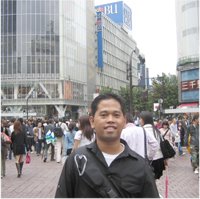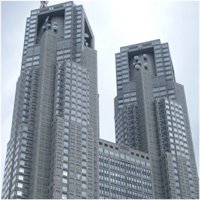Impressions of Japan - Part II

1. Karaoke
Tokyo's karaoke shops are typically similar to the ones found in Hong Kong; small rooms, with space optimally built for everything necessary to fit inside: a sizable cupboard with large television screen, dvd/cd players, amplifiers, a small table and comfy sofas. But Hong Kong's shops are typically made for Hong Kong's fun loving youngsters who prefer to belt out favorite Hong Kong and Taiwan popstars. But wait until you get to browse over Shibuya karaoke's songbook table of contents.
I was singing with Joanne songs from Lionel Richie-Diana Ross duet to Hikaru Utada and from the Eraserheads to Gin Blossoms. I am especially fascinated with the lineup of Original Filipino Music (OPM) titles. While they are not that complete -- You Won't See Me Crying by the Passage was not there -- it still shows the respect of the Filipino talents by the Japanese people.
2. Odaiba
Overlooking Tokyo Bay and the splendid Rainbow Bridge located at Daiba in Minato-ku was a great opportunity for me to see Tokyo with unobstructed views. Not as majestic as Hong Kong's Victoria Harbour, the place somehow exudes less offensive odor than Hong Kong's premier attraction. Walking towards the Telecom Center direction led us to Venus Fort, a theme park-like shopping mall built in 1999. An impressive roof design emulating blue sky and fluffy clouds is something not to miss. Not far from the location is the headquarters of Fuji TV built in a futuristic architecture. I did not get inside but I did not have to because of my self-imposed four-hour time limit and the plenty of views outside, which even started during my train ride through the Yurikamome line.
3. Yokohama
Jun and I went around Minato Mirai and especially got great shots of Kishamichi Promenade which featured views of the giant clock ferris wheel and sea attractions situated nearby a little family recreation area. On the waterfront, little boats for rent are also available. I wasn't interested to ride it, and when we felt a little tremor on that cloudy afternoon, Jun got discouraged as well. Japan's tallest building, the 70-storey Landmark Tower, is located here. This is probably the only time my outdoor sightseeing was not threatened by impending rainshower.
4. Hibiya Park
In the morning of my last day in Tokyo before returning to Hong Kong, I was in trouble locating areas through the map. I intend to go to Hibiya Park and for some reason alighted at Nagatacho station. I had communication problems talking to guards and Filipina scholars walking around were not much of help either since they just got into the city two days ago. Good thing Tokyo is sprinkled with great English-speaking people and I got help from one lady who walked past a koban (police outpost which appears more like a tourist answering booth) and heard the miscommunication. After an hour of walking, photo taking and asking office people where to go, I finally reached my destination. An oasis of the city, Hibiya Park is home to fountains, ponds, trees and people seeking refuge from the typical city life. I see several office workers bringing their bento boxes and take their lunch on various points in the park. Good thing most sign posts and entrance display maps do have English translations. And given that I was unable to go to Hamarikyu Garden, this visit is very much worthwhile.
5. Shibuya
Comparable to Mongkok and Causeway Bay crowds, Shibuya is cramped and busy part of Tokyo's metropolis. Compared to Shinjuku, Shibuya is cleaner and has a safer reputation. Definitely a must see is the statue of Hachiko, the legendary dog. A tear-jerking true story of a master-slave relationship, Hachiko is the dog who waits for his owner every night before going home together. Not known to the dog was that the master died of an accident, Hachiko continues to wait until his ultimate demise on 8th of March, 1935. Many hearts were touched and the dog was honored with a statue found here. I only found myself taking photos at Shibuya Crossing with Jun or waiting for Joanne. I never got to see the gymnasium which hosted the 1964 Olympics, among other interesting places due to the inclement weather conditions.
 6. Shinjuku
6. ShinjukuAfter Hibiya Park, I headed to Shinjuku aiming to take shots of the great structure of Tokyo Metropolitan Government Building, designed by Kenzo Tange. I think it's inspired by the Gothic designs usually found in Europe. Seen better closer than from a distance, Tokyo Metropolitan Government Offices appears like a bunch of boxes intricately packed one after the other. And just like in many places in Tokyo, the building is located on spaces filled with greeneries of Shinjuku Chuo Park, with a refreshing backdrop of trees aligned and leaves still intact just before autumn season starts to paint the area with a more sober look.
Once I arrived at Narita, I was instructed by Jun to take the airport limousine which basically is a bus coach and alight at Shinjuku. So my first impression of Japanese city life was built in this area. A colossal Shinjuku train station handles a mammoth two million passengers everyday! That's four times the entire capacity of Manila's MRT 3 in 2001 (according to its official web site). Shinjuku Dori Avenue and Yasukuni Dori Avenue are probably the largest shopping streets in the area but as the night grew chilly and advancing my watch by an hour, I have to be wary if Jun was more on-time in meeting up. I decided not to wander farther on my first day in Tokyo; I sat at the pavement after a few "shashin" favors from fellow strangers, munching the 90 yen McDonald's burger.

1 Comments:
i enjoyed browsing through your blog. nice impressions of japan. one correction though, "you won't see me crying" was originally recorded by gerry paraiso and len castillo. still better than passage's cover, if you ask me.
By Anonymous, at Thu Sep 14, 07:56:00 PM GMT+8
Anonymous, at Thu Sep 14, 07:56:00 PM GMT+8
Post a Comment
<< Home